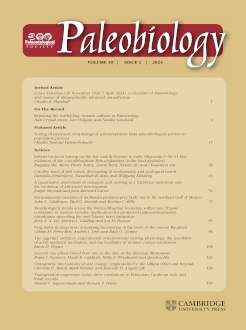The body size of fossil organisms has been an important area of research for paleobiologists for well over a century, because body size can tell us much about widespread trends in the evolution of major groups of living things. However, paleobiologists often study body size by focusing only on size-related information collected from fossils. Without information about a fossil organism's biology and geologic history beyond its size, we cannot understand what is driving body-size change over evolutionary time in a meaningful way.
Luckily, the ways evolutionary biologists already think about growth and development (ontogeny) and evolutionary relationships among taxa (phylogeny) can help us resolve this issue. In particular, by looking at how a species' body size, age, and other observable traits (phenotype) change over its growth and development, we can track how a species' body-size changes over the course of its time on Earth. Furthermore, we can compare these patterns between closely related species, and identify the sources of body-size change in deep time.
To show how these ideas are a practical solution to problems in the fossil record, we applied them to a common pattern called the “Lilliput effect.” Named after the island of Lilliput and its tiny inhabitants in Gulliver's Travels, this pattern describes a sharp decrease in organism body size during extinctions in Earth history. Despite the Lilliput effect being very common, we understand little about how it occurs. Along with providing a stronger definition for the Lilliput effect, we use our framework to note some likely processes for the Lilliput effect (such as changes to development), and some famous cases where we could easily test these ideas.
Body size has a long history of study in paleobiology and underlies many important phenomena in macroevolution. Body-size patterns in the fossil record are often examined by utilizing size data alone, which hinders our ability to describe the biological meaning behind size change on macroevolutionary timescales. Without data reflecting the biological and geologic factors that drive size change, we cannot assess its mechanistic underpinnings.
Existing frameworks for studying ontogeny and phylogeny can remedy this problem, par ticularly the classic age–size–“shape” space originally developed for studies of heterochrony When evaluated based on metrics for age, size, and phenotype in populations, propose mechanisms for size change can be outlined theoretically and tested empirically in the record Using this framework, we can compare ontogenetic trajectories within and between specie and determine how changes in size emerge. Here, we outline ontogenetic mechanisms for evo lutionary size change, such as heterochrony, as well as how geologic factors can drive appar ent non-biolo ical size chan e (e ta honomic size sortin)
To demonstrate the utility of this framework in actual paleobiological problems, we apply it to the Lilliput effect, a compelling and widely documented pattern of size decrease during extinction events. However, little is known about the mechanisms underlying this pattern. We provide a brief history of the Lilliput effect and refine its definition in a framework that can be mechanistically tested. Processes that likely produce Lilliput effects include allometric and sequence repatterning (including heterochrony) and evolutionary size-selective sorting. We describe these mechanisms and highlight relevant examples of the Lilliput effect for which feasible empirical tests are possible.






